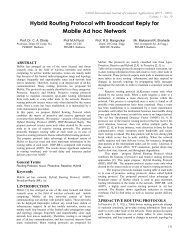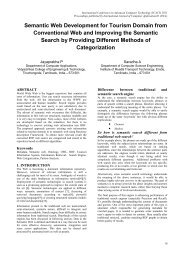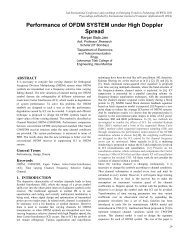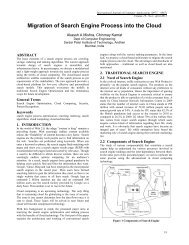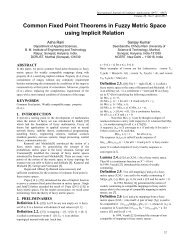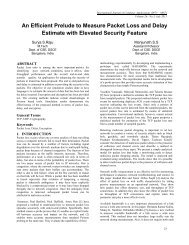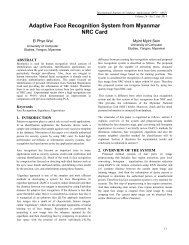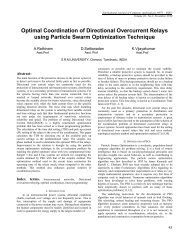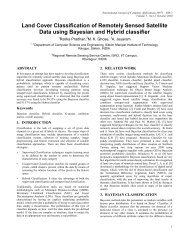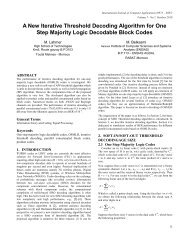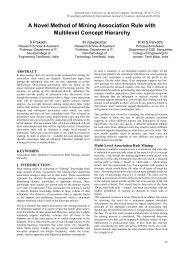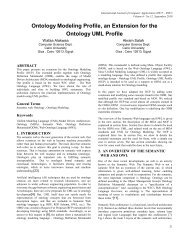Download - International Journal of Computer Applications - IJCA
Download - International Journal of Computer Applications - IJCA
Download - International Journal of Computer Applications - IJCA
Create successful ePaper yourself
Turn your PDF publications into a flip-book with our unique Google optimized e-Paper software.
<strong>International</strong> <strong>Journal</strong> <strong>of</strong> <strong>Computer</strong> <strong>Applications</strong> (0975 – 8887)<br />
Volume 24– No.7, June 2011<br />
An Efficient Unicode based Sorting Algorithm for<br />
Bengali Words<br />
Md. Ruhul Amin<br />
Dept. <strong>of</strong> <strong>Computer</strong><br />
Science and Engineering,<br />
Shahjalal University <strong>of</strong><br />
Science and Technology,<br />
Sylhet-3114, Bangladesh<br />
Asif Mohammed<br />
Samir<br />
Dept. <strong>of</strong> <strong>Computer</strong><br />
Science and Engineering,<br />
Shahjalal University <strong>of</strong><br />
Science and Technology,<br />
Sylhet-3114, Bangladesh<br />
Madhusodan<br />
Chakraborty<br />
Dept. <strong>of</strong> <strong>Computer</strong><br />
Science and Engineering,<br />
Shahjalal University <strong>of</strong><br />
Science and Technology,<br />
Sylhet-3114, Bangladesh<br />
Md. Mahfuzur<br />
Rahaman<br />
Dept. <strong>of</strong> <strong>Computer</strong><br />
Science and Engineering,<br />
Shahjalal University <strong>of</strong><br />
Science and Technology,<br />
Sylhet-3114, Bangladesh<br />
ABSTRACT<br />
This discussion focuses on the sorting algorithm for Bengali<br />
language represented by Unicode character set. A few works has<br />
been done on this topics but no standard is set up yet to sort<br />
Bengali words. Some <strong>of</strong> these works are based on ASCII<br />
representation. To use ASCII, keyboard mapping is important<br />
because it is different for each country where the Unicode<br />
representation is fixed for all characters <strong>of</strong> various countries. So,<br />
Unicode representation is much more preferable than ASCII<br />
representation. In this paper we have discussed about an easy<br />
way to sort the Unicode Bengali texts. In our method, a mapping<br />
is used which simplified the sorting procedure. This method can<br />
sort any Unicode Bengali text and it is not keyboard dependent.<br />
General Terms<br />
Theoretical Informatics.<br />
Keywords<br />
Bengali Word Sorting, Unicode Bengali Sorting, Bengali Text<br />
Sorting<br />
1. INTRODUCTION<br />
Bengali is an eastern Indo-Aryan Language. It is the native<br />
language <strong>of</strong> Bangladesh, the Indian state <strong>of</strong> West Bengal and<br />
parts <strong>of</strong> the Indian states <strong>of</strong> Tripura and Assam. It is written with<br />
the Bengali script. [1] About 181 million people are the native<br />
speaker <strong>of</strong> this language and nearly 250 million people can<br />
speak Bengali in total. It is one <strong>of</strong> the most spoken languages<br />
(ranking sixth) all over the world. [2] It is the national and<br />
<strong>of</strong>ficial language <strong>of</strong> Bangladesh and one <strong>of</strong> the 23 <strong>of</strong>ficial<br />
languages recognized by the Republic <strong>of</strong> India. [1] It is the<br />
<strong>of</strong>ficial language <strong>of</strong> the states <strong>of</strong> West Bengal and Tripura. [1] It<br />
is also a major language in the Indian union territory <strong>of</strong><br />
Andaman and Nicobar Islands. [1] It was made an <strong>of</strong>ficial<br />
language <strong>of</strong> Sierra Leone in order to honor the Bangladeshi<br />
peacekeeping force from the United Nations stationed there. [1] It<br />
is also the co-<strong>of</strong>ficial language <strong>of</strong> Assam.<br />
As the Bengali language is a rich and widely used language, it<br />
must have some standardization such as Bengali keyboard<br />
layout, Bengali character recognition, voice synthesis etc. But<br />
unfortunately we have advanced a very little in this regard. In a<br />
rapidly developing environment <strong>of</strong> computerization <strong>of</strong> Bengali<br />
language, one <strong>of</strong> the most important issues is Bengali text<br />
sorting. For the development <strong>of</strong> Bengali database systems, an<br />
efficient, versatile sorting algorithm is a must. There are some<br />
papers on this topic but none <strong>of</strong> them could set standard for<br />
sorting Bengali text. In this paper, we have shown the analysis<br />
<strong>of</strong> the previously proposed sorting algorithms and the<br />
comparison among the procedures to represent drawbacks,<br />
difficulties and limitations. Based on these observations we have<br />
proposed an algorithm based on Unicode to sort Bengali strings<br />
accurately, and the complexity is satisfying. The proposed<br />
algorithm is readable and very easy to code; hence it has the<br />
potential to be considered as standard algorithm for sorting<br />
Bengali strings. As Bangla Academy [3] is the national academy<br />
for promoting Bangla language in Bangladesh, we are following<br />
the Bangla Academy dictionary standard for our proposed<br />
method.<br />
2. THE BENGALI LANGUAGE<br />
Base Letters: In the written form <strong>of</strong> Bengali alphabets, there are<br />
11 vowels and 39 consonants. When we use these alphabets, we<br />
call it base letters. The vowels are<br />
The consonants are<br />
These are the base letters <strong>of</strong> Bengali language.<br />
Modifiers: There two types <strong>of</strong> modifiers in Bengali, vowel<br />
modifiers and the consonant modifiers.<br />
10 <strong>of</strong> the 11 vowels can be used as modifier to the consonants.<br />
We call them vowel modifier. They can never be used<br />
independently. Here is the list <strong>of</strong> vowel modifier:<br />
Word Vowel Modifier Example<br />
- /kɔlom/<br />
/kɔlɑm/<br />
/piʈʰɑ/<br />
11
<strong>International</strong> <strong>Journal</strong> <strong>of</strong> <strong>Computer</strong> <strong>Applications</strong> (0975 – 8887)<br />
Volume 24– No.7, June 2011<br />
Table-01: Vowel Modifiers<br />
/ʤībon/<br />
/tulɑ/<br />
/suci/<br />
/briʃʈi/<br />
/kæmon/<br />
/hojmo/<br />
/komol/<br />
/ʃowkʰin/<br />
Like the vowel modifiers, the consonants have some short forms<br />
when they used with other consonant. They are called – .<br />
Some <strong>of</strong> them are given below:<br />
Word Consonant Modifier Example<br />
- /ʤɔr/<br />
- /ʤonno/<br />
- /tibro/<br />
Table-02: Consonant Modifiers<br />
Compound Characters: When two or more consonant<br />
characters <strong>of</strong> Bengali alphabet used together, then they are<br />
called the compound characters. There are about 270 compound<br />
characters in Bengali. Some examples <strong>of</strong> compound characters<br />
are given below:<br />
Word<br />
Compound<br />
Character<br />
Decompressed<br />
Form<br />
No. <strong>of</strong><br />
Alphabet<br />
Used<br />
/ujjbol/ 3<br />
/sɔmmɔndʰe<br />
/<br />
Table-03: Compound Characters<br />
3. DIFFICULTIES OF SORTING<br />
BENGALI TEXT<br />
The problem associated with sorting <strong>of</strong> Bengali words are as<br />
follows-<br />
Bengali words should be sorted according to the<br />
Bangla Academy [4] standard. But unfortunately the<br />
Unicode for Bengali characters are not in Bangla<br />
Academy dictionary order. So, mapping is required to<br />
sort words uniquely.<br />
Compound characters ( + + + + = , +<br />
+ = ) make Bengali sorting complicated.<br />
In writing, vowel modifiers ( + = , + = )<br />
can precede or follow the base letter in Bengali words,<br />
but in computation it should be placed after the base<br />
letter for proper sorting.<br />
Unicode characters<br />
can be written in two<br />
ways. For example, can be a single character<br />
(\u09DD) or compound <strong>of</strong> + (\u09A2+\u09BC).<br />
These two cases should be considered as special case<br />
while sorting.<br />
4. POSSIBLE SOLUTIONS<br />
4.1 Method 1<br />
M. Shahidur Rahman et al. [5] have proposed an alternative<br />
representation during computation. According to their proposal a<br />
dummy character is placed after the character, which does not<br />
have any modifier. Moreover, it is also considered that there<br />
would be no dummy character between the constituent parts <strong>of</strong> a<br />
compound character. Generally vowel modifiers can be typed<br />
before or after the characters but for this algorithm the modifiers<br />
are shifted after the character for the internal representation<br />
while computing. In case <strong>of</strong> compound characters, they are<br />
decomposed into their constituent components and stored<br />
accordingly. In Table-4 internal representation <strong>of</strong> few words are<br />
shown where represents the dummy character. To sort the<br />
words the relative order in the character set are arranged in the<br />
following way-<br />
Null modifier < Vowel Modifiers < Vowels < Consonants<br />
2<br />
2<br />
/briʃʈi/ 2<br />
Input<br />
Word<br />
Internal input<br />
Representation<br />
Internal Representation<br />
<strong>of</strong> Sorted Output Word<br />
/ʤuddho/<br />
2<br />
<br />
<br />
/brɑmmon/<br />
2<br />
<br />
12
<strong>International</strong> <strong>Journal</strong> <strong>of</strong> <strong>Computer</strong> <strong>Applications</strong> (0975 – 8887)<br />
Volume 24– No.7, June 2011<br />
<br />
<br />
<br />
Table-04: Internal representation Of Words In [5]<br />
This method has the following drawbacks:<br />
This work is based on ASCII based Bengali words.<br />
In this procedure,<br />
is not considered.<br />
4.2 Method 2<br />
According to Mafizul Haque Khan et al.‟s “An Efficient And<br />
Correct Bangla Sorting Algorithm” [6] a character is represented<br />
with two digit unique number for every letter <strong>of</strong> Bengali<br />
alphabet along with the vowel modifiers and the consonant<br />
modifiers. The letters and their corresponding numbers are given<br />
in Table-05. It is to be noticed that here „ ' is treated as a set <strong>of</strong><br />
two characters that is „ + '. The consonant modifiers are<br />
having the same number as their original consonants.<br />
Character<br />
<br />
Number<br />
, - , , , 11-23<br />
- , - 25-34<br />
, , , , , , , 35-42<br />
, , , , , , , , , 43-52<br />
, , , , , , , 53-61<br />
, , , , , , , , , 71-80<br />
Table-05: Representing A Bengali Character Of Two Digit<br />
For vowel modifiers, wherever its position is (i.e. Left, Right or<br />
Down), its corresponding number will always be visual after the<br />
number <strong>of</strong> the letter over which it was applied. For Example, the<br />
words , , , , and change into numbers<br />
„6171‟,‟6174‟,‟6172‟,‟6179‟ and „6177‟. For Compound<br />
characters 99 is added. For example, for the word- =<br />
, the number will be 259925. For it will be - 60619953.<br />
The difference <strong>of</strong> number <strong>of</strong> digit between the words<br />
(277946755773) and (6021609925764372) is 4. So<br />
according to the algorithm, four zero‟s are appended at the end<br />
<strong>of</strong> the number representing . So finally the number becomes<br />
2779467557730000.<br />
Drawbacks-<br />
<br />
The sequence <strong>of</strong> characters does not maintain the<br />
sequence <strong>of</strong> Bangla Academy [4] .<br />
Adding extra zero‟s at the end <strong>of</strong> the number with less<br />
digit which increases overhead.<br />
4.3 Method 3<br />
Shah Md. Emrul Islam et al. proposed a method to Sort Unicode<br />
Bengali Text Using Ancillary Maps. [7] In this method, the<br />
Unicode characters are mapped and given a Sort Weight. The<br />
structure <strong>of</strong> the Ancillary table is like the following:<br />
Unicode Sort Weight Remarks<br />
0985 01<br />
0986 02<br />
09BE 03 RM<br />
0987 04<br />
09BF 05 LM<br />
. .<br />
. .<br />
09B6 56 BL<br />
09B7 57 BL<br />
. .<br />
09FA 89<br />
09BD 90<br />
Table-06: Structure <strong>of</strong> Ancillary Maps<br />
For each word the mapped value are concatenated and a decimal<br />
point is added after two digits from the starting. Then it becomes<br />
a floating point number. By comparing all the floating point<br />
numbers, the list <strong>of</strong> words is sorted. For example, the word<br />
(Unicode Representation 099509BE09A8099509CB) gets the<br />
value 25.0346002519<br />
The algorithm uses the decimal number system for<br />
determination <strong>of</strong> the value <strong>of</strong> a Bengali Word. There is an<br />
example for two Bengali words " " and " ", the<br />
decimal value becomes 25.005463510030035407 and<br />
25.03546352002500540050034915 respectively. Now it‟s easy<br />
to compare the two numbers. By this way a list <strong>of</strong> Bengali words<br />
can be sorted.<br />
is considered only as a compound character <strong>of</strong><br />
which is incorrect.<br />
13
<strong>International</strong> <strong>Journal</strong> <strong>of</strong> <strong>Computer</strong> <strong>Applications</strong> (0975 – 8887)<br />
Volume 24– No.7, June 2011<br />
Drawbacks<br />
Adds extra complexity while converting a string to<br />
floating point number<br />
The range for the floating point decimal number may<br />
exceed if the length <strong>of</strong> the word is much longer which<br />
will arise round-<strong>of</strong>f error<br />
5. PROPOSED SOLUTION<br />
5.1 Main Process<br />
In our proposed method, at first we mapped all the characters<br />
that are used in Bengali text according to Bangla Academy [4]<br />
sequence.<br />
At the first stage <strong>of</strong> word processing, an extra dummy character<br />
is being added after the base letter which has no modifier. But if<br />
there is a vowel modifier with the base letter then we place that<br />
modifier in place <strong>of</strong> the dummy character. For example, if we<br />
have a word “ ”, then we make it ++ . If there is no<br />
vowel modifier at the end <strong>of</strong> the last letter then the null modifier<br />
is not added. When we consider a compound character, then we<br />
get the base letter, a link character ( ), and then the next<br />
character <strong>of</strong> the compound character and so on. For example, the<br />
word , we get + + + + . This procedure is also maintained<br />
for the letters with consonant modifier. Hence the alternative<br />
representation <strong>of</strong> the Bengali string is obtained.<br />
In the next step, we generate a string <strong>of</strong> digits for each Bengali<br />
string using the map table (Table-07) to obtain a secondary<br />
representation. Then we sort these strings using MergeSort or<br />
any other efficient sorting algorithm using string comparison.<br />
Finally, we convert the secondary representations to its original<br />
Bengali strings.<br />
The rules followed in our approach are-<br />
1. Any character without any modifier is considered as<br />
character followed by null modifier.<br />
2. Any character with by vowel modifier is considered<br />
as character followed by vowel modifier.<br />
3. Any character with consonant modifier is considered<br />
as character followed by link character followed by<br />
consonant.<br />
4. Any compound character is considered as character<br />
followed by link character followed by character.<br />
In our algorithm the precedence <strong>of</strong> the Bengali character is<br />
maintained using the following rule:<br />
Dummy/Null Character < Vowel Modifier < Consonant<br />
Modifier < Vowel < Consonant<br />
5.2 Mapping<br />
The whole mapping (Bengali character to a pair <strong>of</strong> digits) is<br />
given in the table below:<br />
Unicode Character Value<br />
09F9 01<br />
09BE 02<br />
09BF 03<br />
09C0 04<br />
09C1 05<br />
09C2 06<br />
09C3 07<br />
09C7 08<br />
09C8 09<br />
09CB 10<br />
09CC 11<br />
09CD 12<br />
0985 13<br />
0986 14<br />
0987 15<br />
0988 16<br />
0989 17<br />
098A 18<br />
098B 19<br />
098F 20<br />
0990 21<br />
0993 22<br />
0994 23<br />
0982 24<br />
0983 25<br />
0981 26<br />
0995 27<br />
0996 28<br />
0997 29<br />
0998 30<br />
0999 31<br />
099A 32<br />
099B 32<br />
099C 33<br />
099D 34<br />
099E 36<br />
099F 37<br />
09A0 38<br />
09A1 39<br />
09DC 40<br />
09A2 41<br />
09DD 42<br />
09A3 43<br />
09CE 44<br />
09A4 45<br />
09A5 46<br />
09A6 47<br />
09A7 48<br />
14
<strong>International</strong> <strong>Journal</strong> <strong>of</strong> <strong>Computer</strong> <strong>Applications</strong> (0975 – 8887)<br />
Volume 24– No.7, June 2011<br />
Unicode Character Value<br />
09A8 49<br />
09AA 50<br />
09AB 51<br />
09AC 52<br />
09AD 53<br />
09AE 54<br />
09AF 55<br />
09DF 56<br />
09B0 57<br />
09B2 58<br />
09B6 59<br />
09B7 60<br />
09B8 61<br />
09B9 62<br />
09BC 63<br />
Table-07: Our Proposed Map Values (According to the<br />
Bangla Academy Sequence [4] )<br />
5.3 Steps for Sorting Bengali Text<br />
Step 1: At first, for each word a string is generated with<br />
dummy characters where needed. Here we represent the<br />
following words with their internal representations:<br />
Input word<br />
Internal<br />
Representation<br />
/ɑmɑr/<br />
/kɔlɑm/<br />
/ʤukto/<br />
/kɔlom/<br />
/dhɔnyo/<br />
/ɑɑm/<br />
Here the dummy character is „ „.<br />
Step 2: Each <strong>of</strong> the Unicode character will be represented with<br />
string <strong>of</strong> two digits from the map. For the previous example, the<br />
representation <strong>of</strong> Unicode characters is given below:<br />
Input word<br />
Internal<br />
Representation<br />
Representing with<br />
mapped value<br />
/ɑmɑr/ 1401540257<br />
/kɔlɑm/ 2701580254<br />
/ʤukto/ 5505271245<br />
/kɔlom/ 2701580154<br />
/dhɔnyo/ 4801491255<br />
/ɑɑm/ 140154<br />
Step 3: Now these generated strings can be sorted using any<br />
efficient sorting algorithm. After sorting the words <strong>of</strong> previous<br />
example we get the following order:<br />
Input word<br />
Internal<br />
Representation<br />
Representing with<br />
mapped value<br />
/ɑɑm/ 140154<br />
/ɑmɑr/ 1401540257<br />
/kɔlom/ 2701580154<br />
/kɔlɑm/ 2701580254<br />
/dhɔnyo/ 4801491255<br />
/ʤukto/ 5505271245<br />
Step 4: In this step, we retrieve the sorted Bengali words by<br />
reverse mapping.<br />
5.4 Algorithm<br />
The proposed algorithm for sorting Bengali words is given<br />
below-<br />
1. N Total no <strong>of</strong> words<br />
2. for i 1 to N<br />
3. For each word derive MappedString i<br />
4. Sort the Array containing MappedStrings<br />
5. for i 1 to N<br />
6. Reverse map the Bengali words from each<br />
MappedString i<br />
5.5 BengaliSort API<br />
We have implemented our proposed technique in JAVA and<br />
created an API for sorting Unicode Bengali words using this<br />
algorithm. This API contains the classes BengaliSort,<br />
MapDefine, SortWords, MergeSort, QuickSort, RadixSort.<br />
To sort words one <strong>of</strong> the methods below <strong>of</strong> class BengaliSort<br />
has to be called.<br />
void sort(String[] string)<br />
void sort(Collection collection)<br />
void sort(Collection collection, int<br />
fromIndex, int toIndex, boolean WithoutRepeatition)<br />
void sort(String string[], int fromIndex, int toIndex,<br />
boolean WithoutRepeatition)<br />
void sort(String string[], boolean WithoutRepeatition)<br />
void sort(Collection collection, boolean<br />
WithoutRepeatition)<br />
The link for the downloadable BengliSort API<br />
http://www.msoden.com/<br />
5.6 Complexity<br />
Mapping and Reverse Mapping Function<br />
N=total number <strong>of</strong> word in list or input list.<br />
Mapping and reverse mapping is done in linear time. So, the<br />
Complexity <strong>of</strong> conversion from Unicode characters to integer<br />
string is O(N). The complexity <strong>of</strong> reverse mapping is also O(N).<br />
15
<strong>International</strong> <strong>Journal</strong> <strong>of</strong> <strong>Computer</strong> <strong>Applications</strong> (0975 – 8887)<br />
Volume 24– No.7, June 2011<br />
Sorting<br />
Complexity <strong>of</strong> MergeSort for N words = O(Nlog(N))<br />
So, Total Complexity = O(N) + O(Nlog(N)) + O(N)<br />
≈ O(Nlog(N))<br />
6. COMPARISON<br />
Runtime Comparison<br />
Procedures<br />
No <strong>of</strong><br />
Words<br />
Proposed<br />
Approach<br />
An Efficient<br />
And Correct<br />
Bangla<br />
Sorting<br />
Algorithm [6]<br />
An Approach to<br />
sort Unicode<br />
Bengali Text<br />
Using Ancillary<br />
Maps [7]<br />
10000 94 ms 93 ms 16 ms<br />
50000 281 ms 296 ms 63 ms<br />
100000 546 ms 609 ms 156 ms<br />
500000 2730 ms 2980 ms 686 ms<br />
1000000 5756 ms 5632 ms 1498 ms<br />
Table-8: Runtime Comparison<br />
7. OUTCOMES<br />
Comparison in Table-08 shows that, the runtime for “An<br />
Efficient And Correct Bangla Sorting Algorithm [6]” is almost<br />
same as ours. But the proposed mapping does not maintain the<br />
sequence <strong>of</strong> Bangla Academy Dictionary [4] . For the approach<br />
described in “An Approach to sort Unicode Bengali Text Using<br />
Ancillary Maps [4] ” has a much better runtime than proposed<br />
approach because it compares floating point <strong>of</strong> Bengali words.<br />
But this approach has a major problem <strong>of</strong> round-<strong>of</strong>f error.<br />
Above all, the character sequence <strong>of</strong> the approach is not<br />
according to Bangla Academy dictionary [4]. The paper “Bangla<br />
Sorting Algorithm: A Linguistic Approach” [5] is ASCII based<br />
approach, so we did not consider this paper to compare with<br />
other approaches. We proposed a standard approach considering<br />
these drawbacks.<br />
We have sorted the Bengali words using string comparison. This<br />
maintains the Bangla Academy [4] dictionary sequence. So far,<br />
string comparison has not yet been proposed by any other<br />
approach and our total complexity is satisfying. So, our<br />
algorithm can be considered as a standard one.<br />
8. CONCLUSION<br />
In this paper we have proposed an efficient and proper way to<br />
sort Bengali strings that conforms with the proper structure <strong>of</strong><br />
Bengali words i.e. each modifier comes with a base letter. Our<br />
main effort was to maintain the right order according to the<br />
standard set by Bangla Academy while sorting and to preserve<br />
the general complexity <strong>of</strong> standard sorting algorithm. We have<br />
also tested the algorithm with more than 56,000 data taken<br />
randomly from Samsad Bengali-English Dictionary [15] in our<br />
algorithm and the output is completely in proper sequence as<br />
represented in Bangla Academy Dictionary. So this algorithm<br />
has the potential to be considered as the standard procedure for<br />
sorting Bengali strings based on Unicode character.<br />
9. REFERENCES<br />
[1] http://en.wikipedia.org/wiki/Bengali_language Retrieved<br />
2011-05-11<br />
[2] http://en.wikipedia.org/wiki/List_<strong>of</strong>_languages_by_number<br />
_<strong>of</strong>_native_speakers Retrieved 2011-05-11<br />
[3] Bangla Academy: http://en.wikipedia.org/wiki/Bangla_<br />
Academy<br />
[4] Bangla Academy Bengali-English Dictionary, First Edition<br />
June, 1994, Bangla Academy, Dhaka, Bangladesh.<br />
[5] Rahman, Md. Shahidur and Iqbal, Md. Zafar, “Bangla<br />
Sorting Algorithm: A Linguistic Approach”. Proceedings <strong>of</strong><br />
<strong>International</strong> Conference on <strong>Computer</strong> and Information<br />
Technology, Dhaka, 18-20 December 1998, pp. 204-208.<br />
[6] Mafizul Haque Khan, S M Rafizul Haque, Md. Sharif<br />
Uddin, Rahat Khan, A B M Tariqul Islam, “An Efficient<br />
And Correct Bangla Sorting Algorithm” 7 th ICCIT, 2004<br />
Page 125<br />
[7] Shah Md. Emrul Islam and Muhammad Masroor Ali “An<br />
Approach to Sort Unicode Bengali Text Using Ancillary<br />
Maps”, BUET, Dhaka.<br />
[8] Cormen, Thomas and Leiserson, Charles and Rivest,<br />
Ronald: “Introduction to Algorithm”, Prentice – Hall <strong>of</strong><br />
India Private Limited, 1999.<br />
[9] Ellis Horowitz and Sartaz Shani,: "Fundamentals <strong>of</strong><br />
<strong>Computer</strong> Algorithm", Galgotia Publications Limited.<br />
[10] Unicode Consortiumhttp://www.unicode.org/charts/PDF/U0980.pdf<br />
[11] Mohammad, Kazi Din: “Adhunik Bangla Byakoron O<br />
Rochona”<br />
[12] Rajesh Palit, Md. Abdus Sattar, “Representation <strong>of</strong> Bangla<br />
Characters in the <strong>Computer</strong> Systems”, Bangladesh <strong>Journal</strong><br />
<strong>of</strong> <strong>Computer</strong> and Information Technology, Vol. 7, No. 1,<br />
December, 1999.<br />
[13] Masum, Md. Salahuddin, “Study <strong>of</strong> Bangla Conjunctive<br />
Characters for Recognition”, B.Sc.Engg.Thesis,<br />
department <strong>of</strong> <strong>Computer</strong> Scince and Engineering, BUET,<br />
August 2001.<br />
[14] Deitel and Santry “Advanced Java 2 Platform”, Prentice<br />
Hall Publications.<br />
[15] Knuth, Donald “The Art <strong>of</strong> <strong>Computer</strong> Programming”,<br />
Addison-Wisely Publications, Boston<br />
[16] Samsad Bengali-English Dictionary -<br />
http://dsal.uchicago.edu/dictionaries/biswas-bengali/<br />
[17] Ishida, Richard - Bengali script notes<br />
http://rishida.net/scripts/bengali/<br />
16



